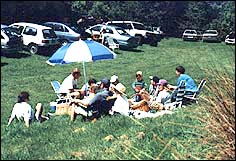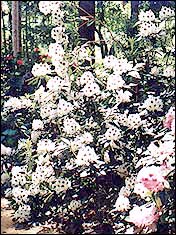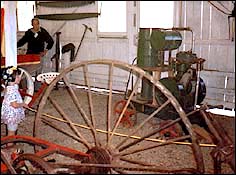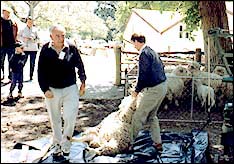Dorothy – 16/4/99
Farm passes to Trustees in 1943. As an interim measure while members of the family were still alive the farm was run by trustees. It had become run down because it had been leased out with no overall management plan for the land. Under the management of the Trustees the dairy herd was built up, gorse was cleared, efforts were made
to control the rabbit and possum population, and some radiata pine and Douglas fir plantations were established on blocks of land unsuitable for grazing.
Establishment of the Orton Bradley Park Board in 1972 In his will Orton Bradley stated that once the last beneficiary of the will had died, the administration of the estate should pass to a board which would develop the property as a national park.
Bradley stipulated that the board should include several local mayors and the chairmen of two local county councils, the president of the Canterbury Horticultural Society, the President of the Canterbury Automobile Association, and the curator of Christchurch City Botanical Gardens. With local body reorganisation a number of these positions have ceased to exist.
The present board includes representatives of the Royal Forest and Bird Protection Society of New Zealand Inc., the Forestry Association, the Arboretum Society, the Automobile Association, the Banks Peninsula District Council, The Christchurch City Council, Lincoln University, a landscape architect, and co-opted members with an independent chair.
Since the early nineties the farm and the Park have been run separately. There is a separate manager for the park living on site.
Interview with Warner Russell, the present park manager Warner Russell explained the recent developments at the Park and some of the future plans.
Current use of the farm The farm land is leased to a partnership who are running 3000 stock units – sheep and cattle. Part of the lease agreement is that the walking tracks
in the farm remain open and the trees remain under the Board’s control.
At present there are 100 hectares of pinus radiata and Douglas fir plantations. It is hope that this area will be increased as the funding for the park does not meet the expenditure. Some forestry income is derived from felling every five years.
The picnic grounds
|
|
| Picnickers in the Park Photo source Orton Bradley Park |
At present 40,000 to 50,000 people a year visit the picnic grounds. They pay an entry fee of two dollars per adult, fifty cents per child, or five
dollars per car. The Board hopes to expand the picnic area.
Day trips by parties and groups from organisations Many organised groups visit the Park for walking or to explore the fauna
and flora or their interest in the history. The old school has been moved from across the road and serves as a shelter for visiting parties in bad
weather.
Park closed 15 August to 15 September Because of the lambing season the park is closed to the public for a month in the spring.
Camping facilities for schoolchildren Parties of children from schools, churches or voluntary organisations are permitted to camp, but they must be largely self sufficient, with their own tents and cooking equipment. Toilets and running water are provided.
The adventure playground built last year is a great attraction for children.
Many Scout camps have been held in the Park over a long period. The YMCA held a camp in January, and space for camps in the park was fully booked in
February and March.
Preservation of the historic buildings in the park Warner Russell paid tribute to the tireless energy of the volunteers and the continued help from the Scout movement which has had links with the Park for many years.
The staff and volunteers have tried to preserve Orton Bradley’s engineering projects and interesting historic buildings in the Park. They have been
faced with problems.
The original buildings These include a millshed and workshop, stables, dairy, and blacksmiths shop.
Homestead destroyed In 1901 a new homestead had been built of kauri and lined with macrocarpa. It held the records of the Bradley family’s occupancy of the property, and
their books, photographs and furniture, but all were lost when the house burned down in 1967.
Wood samples saved 150 wood samples had been collected and labelled by Orton Bradley and mounted on a board. Luckily just before the fire the board had been sent
to Lincoln University for the samples to be re-identified as the labelling had faded and become illegible.
Damage to buildings and trees in the 1968 storm The staff had kept Orton Bradley’s old millshed running and were using it for small jobs like cutting firewood, but the big storm in 1968 damaged much of the machinery. That storm also flattened many of the trees in the park.
Work of volunteers Volunteers, who are members of the Orton Bradley Historical Society, work every Monday repairing and renovating the buildings and machinery in the
Park. They have spent many hours repairing the millhouse and it is now possible to visit on an open day or a Monday afternoon and see the system in operation and have your questions answered.
One of the oldest buildings in Canterbury
|
|
| Old stone cottage dating from 1848 Photo source Peter Hunt |
Visitors can view the stone cottage built in 1848 – one of the oldest buildings in Canterbury. The Manson and Rhodes families build it for their shepherds when they were leasing the land from the Maori before permanent European settlement in the area.
Collection of articles of historical interest Many articles used in homes or on farms in the past have been collected by
volunteers and can be viewed. They await their place in future historical displays. Items range from a horse drawn mobile spray tank, a separator, a cheese press, and a grass sieve to washing and sewing machines, a lead coated sink bench, tobacco tins and an old piano accordion.
At present they are stored in the old stone cottage, the machine shed which came from the leper station of Quail Island and the milking shed, all surrounded by a stone paved yard.
There is also a cemetery for farm dogs which have died since 1950.
Help from the Scouts Scouts helped with the planting of trees and with repair of the millshed, the water race, the water wheel and associated systems. This support has
continued for many years. Their next project was assisting with the removal of the school from its site beside the beach across the road to a new site, first in the golf course next to the Park and finally to the Park itself. Once it was in its new site the scouts helped with the repair and restoration of the old building.
A major project for the volunteers
|
|
| The house with its stone wall – both built by volunteer labour Photo source Peter Hunt |
Within the last five years the volunteers completed a major project involving thousands of hours. In March 1998 they completed the building of a house which is a copy of the first house of Dr Moore. It is built of local macrocarpa and provides a focal point for visitors to the historic
complex.
In 1998 the stone wall was built with stones from the creek – another time consuming project.
Future plans for the house The house will be put to good use.
The information centre will contain information on tracks and on fauna and flora.
Displays are planned to serve as an educational unit, following the sequence of activities in the area – whaling, felling the bush, dairying,
the flax mill, the cocksfoot industry, the quarry, and sheep and cattle farming.
In the building housing the old machinery there will be a display of farming in the eighteenth century. In the boardroom the history of the
Bradley family will be shown and in the kitchen, bedroom and living room historical furniture.
Trees in the park The arboretum This is about twenty minutes walk from the Park buildings. A sign on the entrance drive points the way. Clear information boards indicate the location of different types of trees which include Persian, Japanese and black walnut trees, coastal and dawn redwoods, cedar of Lebanon, atlas and deodar cedars, and swamp cypresses.
It is maintained by the Arboretum Society.
The rhododendron garden
|
|
| Rhododendrons in the Park in flower Photo source Peter Hunt |
This has been developed and is maintained by the Canterbury Rhododendron Society. There is a special rhododendron day in late October. This beautiful garden is featured in a separate NZine article.
The camellia garden A camellia garden was planted by Harold Wilson and is maintained by the Park staff.
More vegetation The Board plans to vegetate Waterfall Gully with more native trees and plants. For jobs of this type they get some assistance from workers on Periodic Detention.
Functions in the Park Multi sport quadrathlon A quadrathlon was held on 24 January. It consisted of a swim in the harbour, kayaking round Quail Island, cycling over Gebbies Pass and back and running eleven kilometres (nearly nine miles) around the top of the Park. A hundred contestants took part.
Music Festival On February 28 a large crowd estimated at 1200 people gathered in the park for easy listening music including barbershop singing groups.
Founder’s Day – December 5, an open day On Founder’s Day the historic buildings are open with working displays of the machinery. Volunteers are on hand as guides. Stalls sell local crafts and a sausage sizzle sells lunch for visitors.
|
|
| Visitors view the old agricultural machinery on Founders Day. Photo source Orton Bradley Park |
|
|
| A sheep shearing demonstration on an open day using an old 1920s shearing plant Photo source Orton Bradley Park |
Heritage Week In October there is a special open day for Heritage Week when places of historic interest in and around Christchurch join to raise interest in what was achieved in the nineteenth and early twentieth century.
Mark a visit to Orton Bradley Park on your calendar. For a day of relaxation, of exercise or of exploring history plan a visit to this beautiful and interesting place only a short drive from Christchurch.










